Mindfulness meditation techniques provide effective stress relief and emotional balance. These practices foster present-moment awareness, enhance self-awareness, and improve emotional regulation. Beginners may face challenges like maintaining focus and managing distractions. Various resources, including apps like Headspace and Calm, offer guidance for integrating mindfulness into daily life.
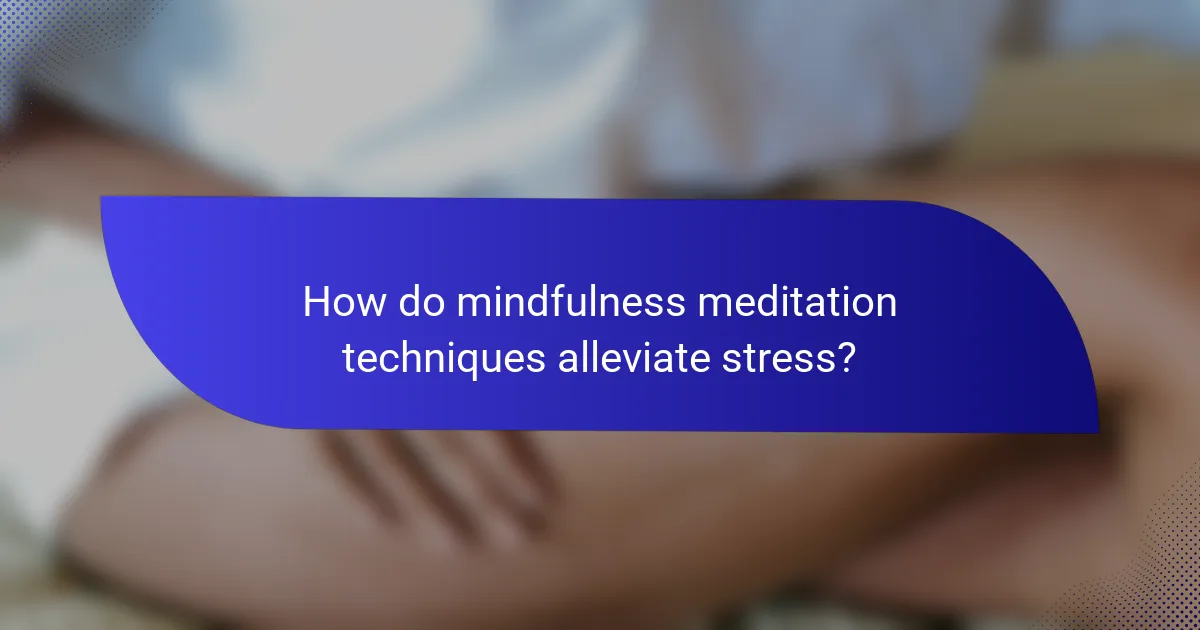
How do mindfulness meditation techniques alleviate stress?
Mindfulness meditation techniques effectively alleviate stress by promoting relaxation and enhancing emotional balance. These techniques, such as focused breathing and body scans, activate the parasympathetic nervous system, reducing cortisol levels. Regular practice leads to increased self-awareness and improved emotional regulation. Research shows that participants report up to a 30% reduction in perceived stress after consistent mindfulness meditation. By fostering present-moment awareness, individuals can better manage anxiety and cultivate a positive mindset.
What physiological changes occur during mindfulness meditation?
Mindfulness meditation induces several physiological changes that promote stress relief and emotional balance. These changes include reduced heart rate, lower blood pressure, and decreased levels of the stress hormone cortisol. Additionally, mindfulness practice enhances brain function, particularly in areas related to emotional regulation and self-awareness. Regular engagement in mindfulness meditation can lead to improved immune function and increased gray matter density in the brain, contributing to overall mental well-being.
Which mindfulness techniques are most effective for stress relief?
Mindfulness techniques such as body scan, loving-kindness meditation, and breath awareness are effective for stress relief. These practices enhance emotional balance by promoting relaxation and reducing anxiety.
Body scan meditation focuses on bodily sensations, helping individuals recognize and release tension. Loving-kindness meditation fosters compassion towards oneself and others, which can alleviate feelings of isolation. Breath awareness emphasizes the present moment, grounding individuals and calming the mind.
Research shows that regular mindfulness practice can reduce cortisol levels, a key stress hormone. Engaging in these techniques for just a few minutes daily can lead to significant improvements in mental well-being.
How does regular practice influence stress levels over time?
Regular practice of mindfulness meditation significantly reduces stress levels over time. Studies show that consistent meditation enhances emotional regulation and decreases anxiety. This practice fosters a state of relaxation, leading to lower cortisol levels, the stress hormone. Over weeks and months, individuals report improved resilience to stressors, enhanced focus, and greater emotional balance. Regular engagement in mindfulness techniques cultivates a lasting sense of calm and well-being.
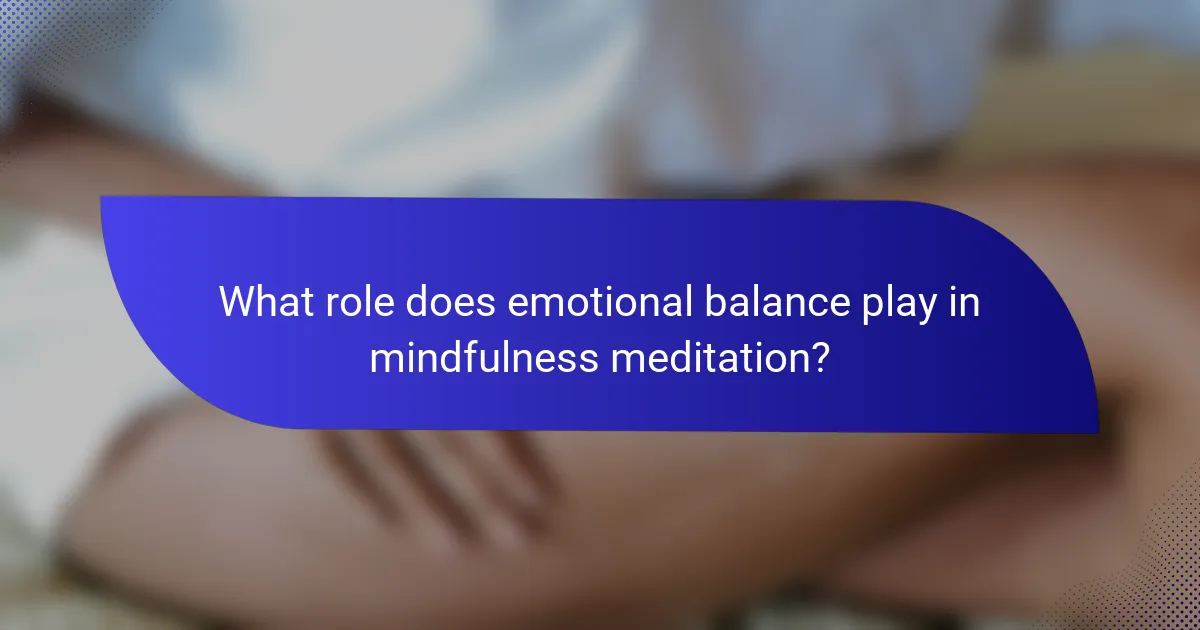
What role does emotional balance play in mindfulness meditation?
Emotional balance is essential in mindfulness meditation as it enhances stress relief and overall well-being. Practicing mindfulness helps individuals recognize and regulate their emotions, leading to improved emotional stability. This technique fosters self-awareness, allowing practitioners to observe their thoughts and feelings without judgment. As a result, emotional balance is achieved through consistent mindfulness practice, which can reduce anxiety and promote a sense of calm. Research indicates that individuals who engage in mindfulness meditation experience lower levels of emotional reactivity, contributing to a more balanced emotional state.
How can mindfulness meditation enhance emotional regulation?
Mindfulness meditation enhances emotional regulation by promoting awareness and acceptance of emotions. This practice encourages individuals to observe their thoughts and feelings without judgment, leading to improved emotional resilience. Research indicates that regular mindfulness meditation can reduce emotional reactivity and increase emotional stability, enabling better responses to stressors. Techniques such as focused breathing and body scans help cultivate this awareness, fostering a balanced emotional state.
Which techniques are best for achieving emotional balance?
Mindfulness meditation techniques such as focused breathing, body scan, and loving-kindness meditation effectively promote emotional balance. These practices enhance self-awareness, reduce stress, and foster a sense of calm. Regular engagement can lead to lasting emotional resilience.
What are the signs of improved emotional balance through meditation?
Improved emotional balance through meditation is indicated by increased self-awareness and reduced reactivity. Practitioners often experience greater emotional stability, enhanced focus, and a more positive outlook. Other signs include improved stress management, better relationships, and a deeper sense of calm. Regular meditation can lead to a notable reduction in anxiety and depressive symptoms, fostering resilience against emotional disturbances.
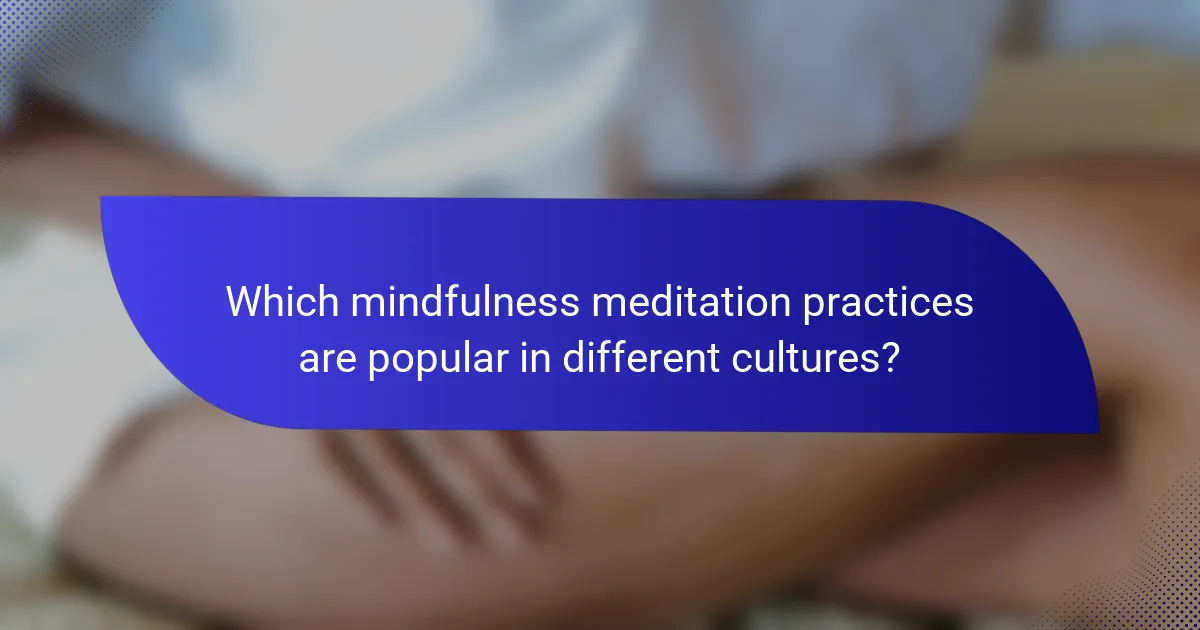
Which mindfulness meditation practices are popular in different cultures?
Mindfulness meditation practices vary widely across cultures, each offering unique techniques for stress relief and emotional balance. Popular practices include Zen meditation from Japan, which emphasizes breathing and mindfulness in the present moment. Vipassana meditation, rooted in Buddhist traditions, focuses on insight and self-awareness. In India, Transcendental Meditation employs a mantra for deep relaxation. Tibetan meditation incorporates visualization and compassion. Mindfulness practices in Western cultures often blend techniques from various traditions, emphasizing accessibility and integration into daily life. Each of these practices uniquely contributes to emotional well-being and stress management.
How does the approach to mindfulness differ between Eastern and Western practices?
Eastern and Western mindfulness practices differ primarily in their philosophical foundations and techniques. Eastern practices, such as those rooted in Buddhism, emphasize awareness and acceptance through meditation, often focusing on the interconnectedness of all beings. Western approaches tend to prioritize cognitive techniques, integrating mindfulness into therapeutic contexts to alleviate stress and promote emotional balance.
Eastern mindfulness often involves prolonged meditation sessions, while Western methods may include shorter, structured exercises aimed at immediate stress relief. This distinction highlights the unique attributes of each practice, with Eastern techniques fostering deep introspection and Western techniques promoting practical applications in daily life.
What unique techniques are used in specific cultural contexts?
Mindfulness meditation techniques vary across cultures, each offering unique methods for stress relief and emotional balance. For example, Zen meditation emphasizes breath awareness and observing thoughts without attachment, while Transcendental Meditation focuses on mantra repetition to achieve deep relaxation. In Tibetan Buddhism, visualization techniques are employed to cultivate compassion and emotional stability. Additionally, Indian yoga incorporates mindfulness through asanas and breath control, promoting physical and mental harmony. Each cultural context enriches mindfulness practices, enhancing their effectiveness for emotional well-being.
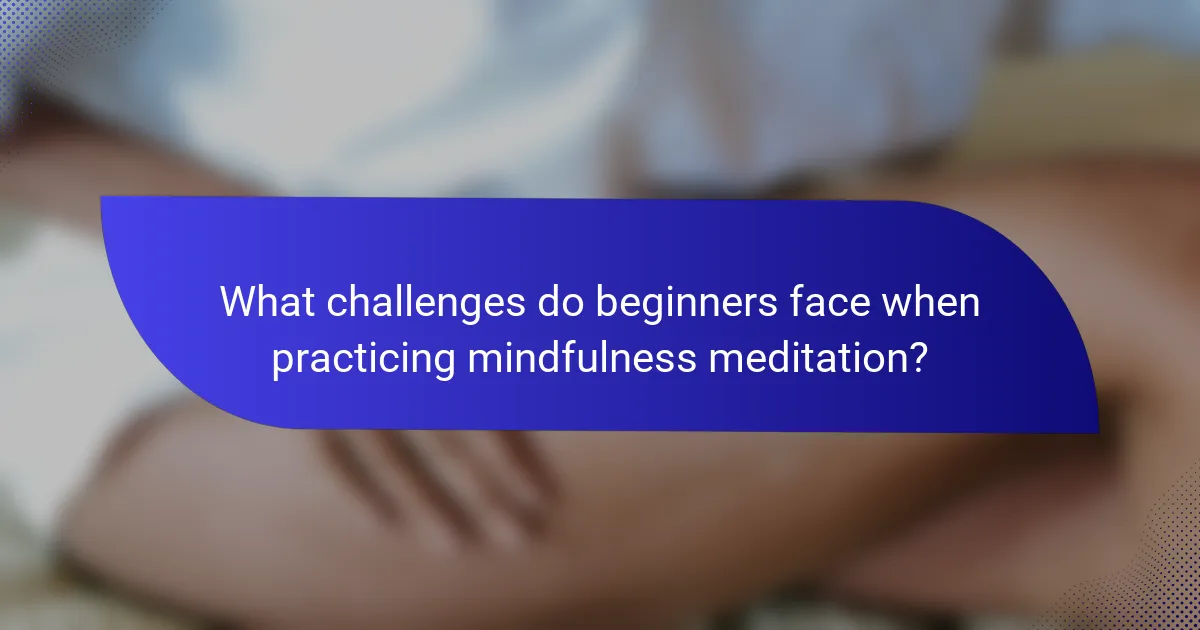
What challenges do beginners face when practicing mindfulness meditation?
Beginners often face challenges such as difficulty maintaining focus, managing distractions, and experiencing frustration with their progress. These hurdles can hinder the effectiveness of mindfulness meditation for stress relief and emotional balance.
Common issues include wandering thoughts, which can disrupt the meditation experience. Beginners may also struggle with the expectation of immediate results, leading to disappointment. Additionally, finding a suitable environment for practice can be challenging, as external noise or interruptions can affect concentration.
As a result, it is important for beginners to cultivate patience and establish a consistent practice. Gradually increasing meditation duration and incorporating guided sessions can help overcome these initial obstacles.
How can distractions impact the effectiveness of meditation?
Distractions can significantly reduce the effectiveness of mindfulness meditation. They disrupt focus and prevent deeper engagement with the practice. Common distractions include noise, intrusive thoughts, and digital devices. These interruptions can lead to a fragmented experience, making it difficult to achieve the intended stress relief and emotional balance. Creating a dedicated, quiet space for meditation can help mitigate these distractions.
What common misconceptions hinder mindfulness practice?
Common misconceptions that hinder mindfulness practice include the belief that it requires emptying the mind, that it is only for certain types of people, and that it demands extensive time commitments. Many people think mindfulness means stopping thoughts entirely, which is inaccurate; it involves observing thoughts without judgment. Additionally, some believe mindfulness is only beneficial for those with specific backgrounds or experiences, while in reality, it is accessible and beneficial for everyone. Lastly, the misconception that mindfulness requires hours of practice can discourage beginners; even a few minutes daily can yield significant benefits for stress relief and emotional balance.
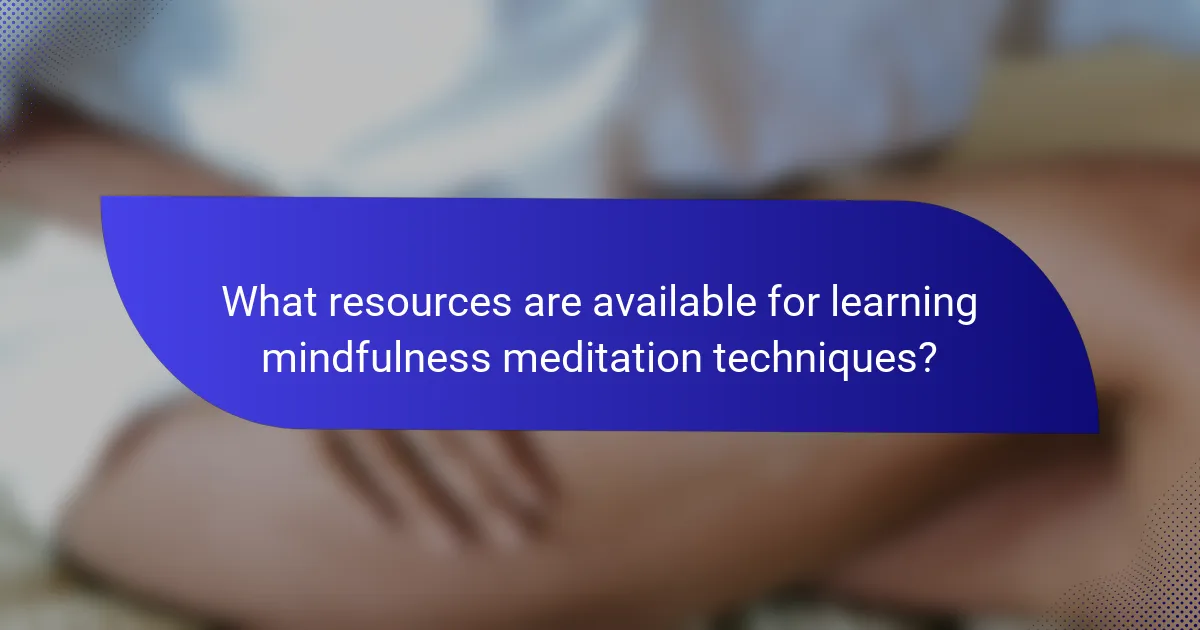
What resources are available for learning mindfulness meditation techniques?
Numerous resources exist for learning mindfulness meditation techniques. These include online courses, mobile applications, books, and local workshops.
Online platforms like Headspace and Calm offer guided sessions tailored for stress relief and emotional balance. Mobile apps provide flexibility for practice anytime. Books such as “The Miracle of Mindfulness” by Thich Nhat Hanh offer in-depth insights and techniques. Local workshops often provide hands-on instruction and community support.
Additionally, YouTube channels dedicated to mindfulness offer free guided meditations. These resources cater to various learning preferences, making mindfulness accessible to everyone.
Which apps and online platforms offer guided mindfulness sessions?
Numerous apps and online platforms offer guided mindfulness sessions. Popular options include Headspace, Calm, Insight Timer, and 10% Happier. These platforms provide various techniques for stress relief and emotional balance, catering to different preferences and experience levels.
What role do local community centers play in promoting mindfulness?
Local community centers play a vital role in promoting mindfulness by providing accessible spaces for meditation and wellness programs. They often host workshops that teach mindfulness techniques, helping individuals manage stress and enhance emotional balance. Community centers foster social connections, which are essential for mental well-being. Additionally, they may offer resources like guided meditation sessions and mindfulness classes, making these practices more approachable for diverse populations. Through these initiatives, community centers contribute significantly to the overall mental health of the community.
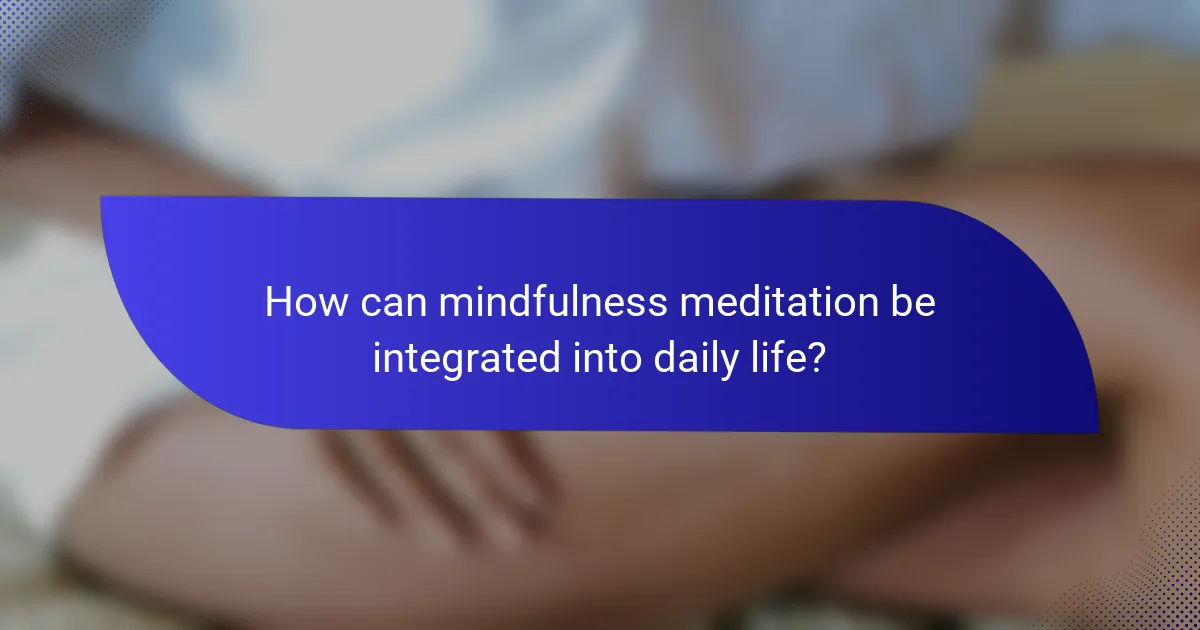
How can mindfulness meditation be integrated into daily life?
Mindfulness meditation can be seamlessly integrated into daily life through simple practices. Start with short sessions, such as five minutes in the morning, focusing on breath awareness. Gradually increase duration as comfort grows. Incorporate mindfulness during routine activities, like eating or walking, by paying full attention to sensations and surroundings. Use reminders, such as phone alerts, to pause and practice mindfulness throughout the day. Engaging in guided meditations via apps can provide structure and motivation. Consistency is key, aiming for daily practice to cultivate emotional balance and reduce stress effectively.
What are practical strategies for incorporating mindfulness into a busy schedule?
Incorporating mindfulness into a busy schedule can be achieved through simple strategies. Start with short meditation sessions, even five minutes, to cultivate awareness. Utilize breaks for mindful breathing or stretching. Prioritize mindful eating by focusing on meals without distractions. Integrate mindfulness into daily activities, such as walking or commuting, by paying attention to surroundings. Schedule regular check-ins throughout the day to assess your mental state and refocus. These practical techniques enhance stress relief and emotional balance.
How can workplace mindfulness programs improve employee well-being?
Workplace mindfulness programs significantly enhance employee well-being by reducing stress and promoting emotional balance. These programs often incorporate mindfulness meditation techniques, which can lead to improved focus and resilience. Research indicates that such practices can decrease anxiety levels by 32% and increase overall job satisfaction. Regular participation in mindfulness activities fosters a supportive work environment, encouraging collaboration and reducing burnout rates. Ultimately, these programs contribute to a healthier workplace culture, benefiting both employees and organizations.
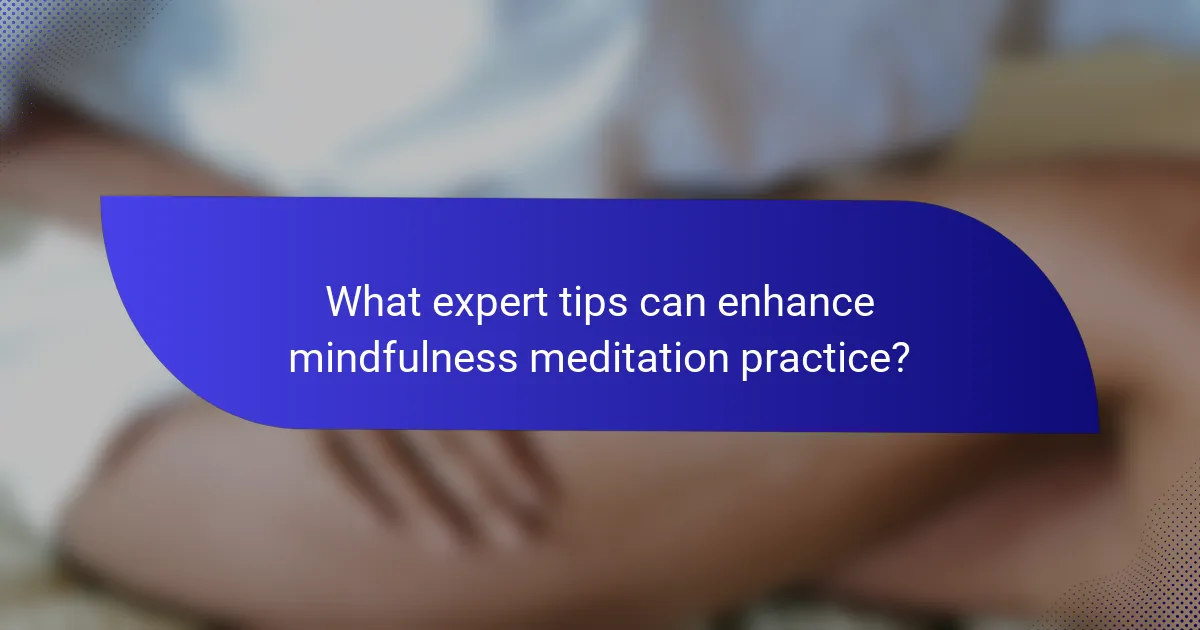
What expert tips can enhance mindfulness meditation practice?
To enhance mindfulness meditation practice, incorporate these expert tips. Establish a consistent routine to foster discipline. Focus on your breath to anchor your awareness. Use guided meditations to deepen your experience. Experiment with different techniques, such as body scans or loving-kindness meditation, to find what resonates. Reflect on your progress to cultivate a sense of gratitude and motivation.
What common mistakes should practitioners avoid?
Practitioners should avoid common mistakes such as rushing the process, neglecting proper posture, and allowing distractions. Additionally, failing to set a consistent practice schedule can hinder progress. Ignoring breath awareness and not being patient with oneself can also lead to frustration. Lastly, comparing one’s practice to others can detract from personal growth.
How can one measure progress in mindfulness meditation?
Progress in mindfulness meditation can be measured through self-reflection, tracking meditation duration, and assessing emotional responses. Keeping a journal helps identify changes in stress levels and emotional balance over time. Regularly evaluating these aspects provides insight into the effectiveness of techniques used.
What best practices support long-term commitment to mindfulness meditation?
Practicing mindfulness meditation consistently fosters long-term commitment. Establish a daily routine to create a habit. Set achievable goals and gradually increase meditation duration. Incorporate various techniques, such as guided meditations or mindful breathing, to maintain interest. Engage with a community or attend classes for support. Track progress to visualize growth and stay motivated.